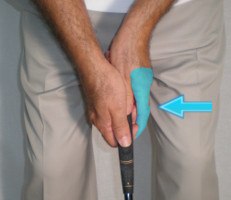
Reverse Overlap Putting Grip
The reverse overlap putting grip is a popular grip used by many professional golfers and amateurs to enhance their putting accuracy and control. It is a grip style that involves overlapping the fingers of the top hand in a reverse manner, providing a secure and stable hold on the putter.
- Improved Stability: The reverse overlap putting grip offers improved stability and control over the putter. By overlapping the fingers of the top hand, the grip becomes more solid, reducing any unnecessary movement in the wrists and hands during the putting stroke.
- Consistency: The reverse overlap grip helps promote a smoother and more consistent putting stroke. With the fingers of the top hand securely positioned, it becomes easier to create a pendulum-like motion with the putter, leading to better distance control and accuracy on the greens.
- Alignment: Proper alignment is crucial in putting, and the reverse overlap grip helps ensure that the putter face is square to the target line. The overlapping fingers of the top hand act as a guide, allowing you to better position the putter face and align it with the desired target point.
- Comfort: Many golfers find the reverse overlap putting grip more comfortable compared to other grip styles. The overlapping of the fingers provides a natural and relaxed position for the hands, minimizing tension and allowing for a more fluid putting stroke.
- Adaptability: The reverse overlap putting grip is versatile and can be adjusted to fit different hand sizes and grip preferences. You can experiment with the position and pressure of your fingers to find the most comfortable and effective grip for your putting game.
Here are some key steps to adopting the reverse overlap putting grip:
- Hold the putter with your lead hand (left hand for right-handed golfers) just below the top of the grip.
- Place the pointer finger of your top hand (right hand for right-handed golfers) alongside the index and middle fingers of your lead hand, resting it gently on the grip.
- Let the pinky finger of your top hand overlap the gap between the middle and index fingers of your lead hand.
- Keep your grip pressure firm enough to control the putter, but not overly tight to avoid tension in your hands and wrists.
- Position the putter handle in the lifeline or center of your palm for optimal control and stability.
Remember, it may take some time to become comfortable with the reverse overlap putting grip, so practicing it on the putting green is essential. Focus on maintaining a smooth and pendulum-like stroke while maintaining a consistent grip pressure. With practice, this grip can help you become a more confident and effective putter.





